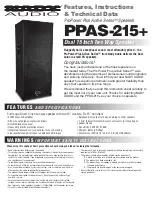
Listening Positions
If you want the freedom to sit anywhere in
a room facing any direction, and/or find
that you prefer the “all around you” sound
of some car stereos to a conventional
“sound stage” facing you, consider the
speaker placement techniques profession-
al installers use in restaurants and bars.
They place speakers in an array around
the listening area, so that the music is
always surrounding you, regardless of the
direction you face.
The rule of thumb is to add one pair of
speakers for every 100 to 200 square feet
of listening area. Curiously, this is not so
that you can play the music louder, but so
that you can play it softer! When you
have only one pair of speakers in a large
room you will notice that when the sound
is perfect in one part of the room, it is too
loud near the speakers. By placing more
than one pair in the room you will avoid
these “hot spots” of loud sound and you
will create more sonic ambiance while
maintaining clarity and a rich sound
everywhere
(See Figure 5)
.
You can make the listener position less
critical by using mono rather than stereo.
This can be difficult to achieve with
normal stereo amplifiers. However, Niles
manufactures Systems Integration
Amplifiers
®
which enable one room to be
wired in stereo while other rooms are
wired in mono! Consult your local Niles
dealer for more information.
In smaller rooms or rooms that are infre-
quently used, you typically can’t justify the
expense of more than two speakers. Try to
bracket the room with the two speakers.
Diagonal placement is a very effective way
to stretch the coverage pattern of two
speakers. You can also compromise
between direct sound (for detail and clari-
ty) and reflected sound (the ambient or “all
around you” effect). The speakers can be
placed near corners to create more reflect-
ed sound. By directing the tweeters to
point away from the listener, so they create
as much reflected sound as possible, you
emphasize the ambient effect. The more
reflected sound there is in the room the
stronger the ambient effect at low volumes.
You should use moderation, however,
otherwise the compromise becomes too
one sided and at high volumes, the sound
will be blurred and less distinct.
Placement for Home Theater
Rear Applications
In a home theater, the goal is to reproduce
the experience of a great movie theater in
our homes. The biggest difference between
the two is the rear or surround speaker
array in a commercial theater. Here, it is
not uncommon to see twenty or thirty
speakers around the audience. This huge
array of speakers assures that you will feel
completely surrounded by the ambient
soundtrack of the movie. Film makers
try to use the “surround” soundtrack to
envelope you in the environment on
screen. They will place background music,
rain sounds, traffic noise, etc. on the
“surround” soundtrack. In a home with a
single pair of speakers it is easy for the jun-
gle sounds to sound like they are “in the
middle of your head” just like headphones!
A single pair of DS8300AT and DS8500AT
Loudspeakers, properly placed, can create
a very convincing simulation of an array
of speakers. If you place them near a hard
reflecting surface you can make one pair
of speakers sound like several. Create as
many reflections as possible by placing
the speakers near a corner so that the
adjoining walls will act as a powerful
reflector. Direct the tweeters so that sound
is pointed away form the listener creating
still more reflections and thus more “sur-
round sound” effect. However, as you
move the speaker farther away from the
listener, both the reflected and the direct
sound will dissipate, requiring more
7
Speak
er Placemen
t









































